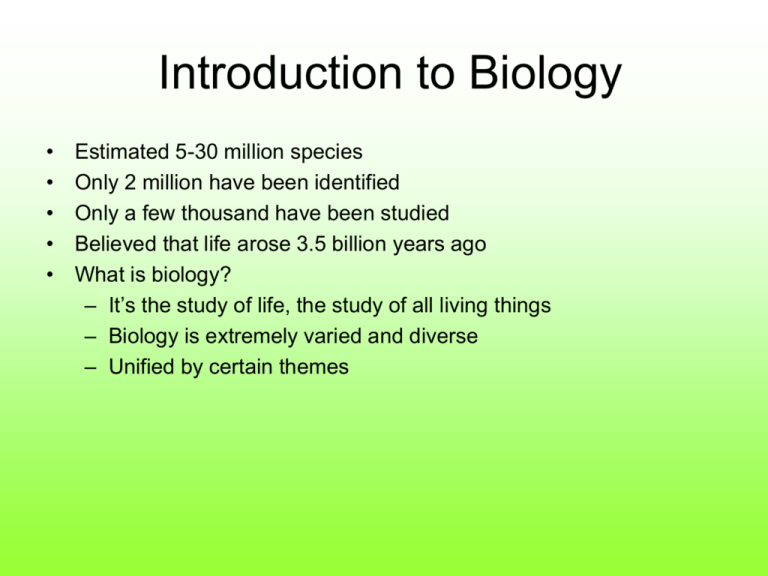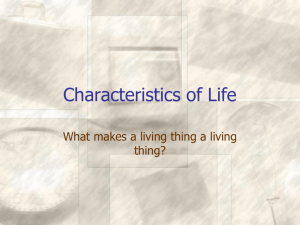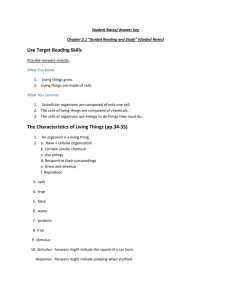Intro to bio
advertisement

Introduction to Biology • • • • • Estimated 5-30 million species Only 2 million have been identified Only a few thousand have been studied Believed that life arose 3.5 billion years ago What is biology? – It’s the study of life, the study of all living things – Biology is extremely varied and diverse – Unified by certain themes Characteristics of life • • • YouTube - 8 Characteristics of Living Things.mov Living things are made up of cells – Cell is the smallest unit of an organism that is considered to be alive Living things reproduce – All organisms reproduce sexually or asexually. – What’s the difference? – Asexual reproduction • When hereditary information from different organisms is not combined • A cell splits into two and one cell gives rise to 2 cells • Example- bacteria and plants – Sexual reproduction • When hereditary information from 2 parts of a single organism or when 2 organisms of the same species is combined • Example- humans, dogs, plants • Living things are based on a universal genetic code. – All organisms store complex information needed for life, growth and reproduction in a molecule called DNA • Living things grow and develop – Start from single fertilized egg, divides again and again-differentiation • Living things obtain and use material and energy – Metabolism-organism builds up and breaks down materials through chemical reactions • Living things respond to their environment – Stimulus- a signal to which organism detects and responds to Characteristics of Life • Living things maintain a stable internal environment – Homeostasis-organisms maintain a relatively stable internal environment • Taken as a group, living things evolve – Basic traits passed on from parents don’t change, but over generations, given groups of organisms typically evolve, or change • May find 2.5 billion unicellular organisms in a single gram of fertile soil • The world of biology is very diverse and rich Themes of Biology • Science as a way of knowing – Use observations, questions, and experiments to explain the natural world • Interdependence in Nature – All organisms are linked together and with their environment • Matter and Energy – Matter and energy is transferred from organism to organism • Cellular basis of life – Cells grow, respond to their surroundings and reproduce – Multicellular and unicellular • Information and heredity – DNA is different in every organism • Unity and diversity of life – All living things are fundamentally alike at molecular level – All composed of common set of carbon-based molecules, all use protein to build structures, and carry out their functions, all store information in common genetic code • Evolution – Explains the inherited similarities as well as the diversity of life – Also known as a change in allele frequency in a population over time – Natural Selection is the most important driving force behind evolution - It says organisms with favorable traits are better able to successfully reproduce than organisms that lack these traits • Structure and function – All organisms use some kind of structure that has evolved in ways that make particular function possible • Homeostasis – All organisms expend energy to keep conditions inside their cells within certain limits – Examples: temperature, water content, food intake – Examples: dogs-pant, seals-fat layer • Science, Technology, and Society – Many scientific discoveries raise ethical questions Levels of Organization • Molecules-groups of atoms; smallest unit of most chemical compounds • Cells- smallest functional unit of life • Groups of cells- tissues, organs, and organ systems • Organism- Individual living thing • Population- Group of organisms of one type that live in the same area • Community- Populations that live together in a defined area • Ecosystem- Community and its nonliving surroundings • Biosphere- The part of Earth that contains all ecosystems







